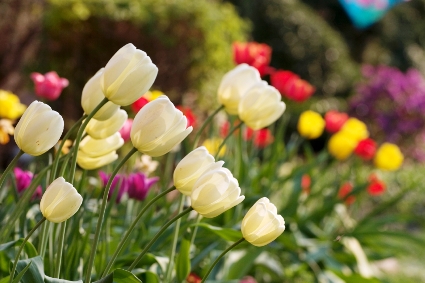Have you ever heard of “spring fever”? (No, it’s not the same as hay fever.) Today, we’re talking about the difference betwen “spring fever” and its negative side, “spring tiredness”. Read on for some helpful tips on how to stay active and healthy in spring.
Finally! In the past week, spring has arrived here in Munich. Last weekend, sunshine and blue skies lured the locals out of their cozy apartments: everyone switched off their central heating, flung the windows open, and then took to the streets.
Beergardens, open-air cafés, and ice-cream parlors were packed as though they were all to be closed tomorrow. Munich is firmly in the thrall of “spring fever”.
“Spring Fever” vs. “Spring Tiredness”
In English, you talk of said “spring fever” to refer to the sudden increase in energy, vitality, and even libido that many people feel once the cold season’s over at last. In German, however, there’s a different expression.
Frühjahrsmüdigkeit literally means ‘spring tiredness’. Indeed, more than a few folks go through an annual bout of Frühjahrs- müdigkeit before they eventually enjoy the beneficial effects of spring fever.
In regions particularly affected by seasonal changes, for example large parts of Europe and North America, spring tiredness is a fairly common phenomenon. The closer you live to the equator, the less impact it has. In the sub-tropics and tropics, it shouldn’t be an issue at all.
It’s Those Pesky Hormones!
Spring tiredness usually rolls around in March or April – in the Northern Hemisphere, that is – and last for several days, if you’re lucky, and for up to one month, if you’re not. Typical symptoms include sleepiness, exhaustion, dizziness, headaches, and mood swings.
It’s not an actual disease, but it can be really irritating. Why do so many of us have to put up with those annoying ailments when we’d rather bask in the sunny weather?
Well, we just can’t deny our animal nature. Us human beings don’t hibernate and then wake up again like so many other mammals, but we do get a slight “hangover” after the long, cold darkness of the winter months. Once daylight hours lengthen and temperatures rise, our body reacts to these changes.
 The brain starts curbing the production of melatonin (the hormone that regulates our sleep-wake cycle) and begins to ramp up serotonin and endorphins instead. These substances are responsible for many bodily functions (such as feeling pain or hunger), but they are widely known as “happiness hormones” for a reason. However, until our hormonal levels are perfectly balanced, our body gets a bit confused, simply speaking.
The brain starts curbing the production of melatonin (the hormone that regulates our sleep-wake cycle) and begins to ramp up serotonin and endorphins instead. These substances are responsible for many bodily functions (such as feeling pain or hunger), but they are widely known as “happiness hormones” for a reason. However, until our hormonal levels are perfectly balanced, our body gets a bit confused, simply speaking.
Moreover, warmer temperatures widen our blood vessels. which makes the blood circulate more freely through our veins, but which also causes our blood pressure to drop. If you have low blood pressure to begin with, this will contribute even further to your general lack of energy and moodiness.
How to Keep Active and Healthy
In short, we suffer from a kind of seasonal “mini-jetlag” until we’ve adjusted to the new environment. Fortunately, there are plenty of things you can do to feel fit and healthy again!
• Natural light and fresh air are the two easiest remedies. Venture outdoors for a brisk walk as often as possible – even if it’s cloudy and cool outside.
• If you are a sporty kind of person, this is the perfect opportunity to indulge in some exercise. Endurance sports such as swimming, running, hiking, Nordic walking, or cycling are particularly recommended.
 • Even if you are very tired, try to adopt a regular sleep schedule that follows the sun, more or less: early to bed and early to rise, and perhaps a short power nap after lunch. (Emphasis on short!)
• Even if you are very tired, try to adopt a regular sleep schedule that follows the sun, more or less: early to bed and early to rise, and perhaps a short power nap after lunch. (Emphasis on short!)
• Alternating hot and cold showers will also raise your energy levels. If you aren’t brave enough to begin your day like this, the occasional visit to the sauna will do the trick just as well.
What (Not) to Eat
Vitamins and proteins are good for you, too. In winter, we tend to eat rich and heavy foods: this is another reminder of our mammalian forebears, who needed protective layers of fat during times of scarcity. Furthermore, before greenhouses and freezers were invented, fresh produce was often hard to come by after harvest time.
In spring, you should switch to plenty of fresh fruit and veggies, as well as lighter dishes, for instance fish, grilled chicken, or tofu. Don’t forget to drink lots of mineral water and herbal tea as well, and lay off the alcohol and hot chocolate for a while.
Of course, you shouldn’t overdo the self-chastisement. You still want to enjoy the spring fever, don’t you?
Just go outside, take a long walk, and sit down in a nice café afterwards. Maybe you could switch the ice-cream sundae for a fruit salad, but you can still soak in the sunshine regardless.
What are you doing to keep fit and healthy in spring?
(Image credit: iStockphoto.com)